
Vermicompost (vermi-compost) is the product of the decomposition process using various species of worms, usually red wigglers, white worms, and other earthworms, to create a mixture of decomposing vegetable or food waste, bedding materials, and vermicast. This process is called vermicomposting, with the rearing of worms for this purpose is called vermiculture.

Lumbricus terrestris is a large, reddish worm species thought to be native to Western Europe, now widely distributed around the world. In some areas where it is an introduced species, some people consider it to be a significant pest for out-competing native worms.

The genus Lumbricus contains some of the most commonly seen earthworms in Europe among its nearly 700 valid species.

The Lumbricidae are a family of earthworms. About 33 lumbricid species have become naturalized around the world, but the bulk of the species are in the Holarctic region: from Canada and the United States and throughout Eurasia to Japan. An enigmatic species in Tasmania is Eophila eti. Currently, 670 valid species and subspecies in about 42 genera are recognized. This family includes the majority of earthworm species well known in Europe and Asia.

Oligochaeta is a subclass of soft-bodied animals in the phylum Annelida, which is made up of many types of aquatic and terrestrial worms, including all of the various earthworms. Specifically, oligochaetes comprise the terrestrial megadrile earthworms, and freshwater or semiterrestrial microdrile forms, including the tubificids, pot worms and ice worms (Enchytraeidae), blackworms (Lumbriculidae) and several interstitial marine worms.
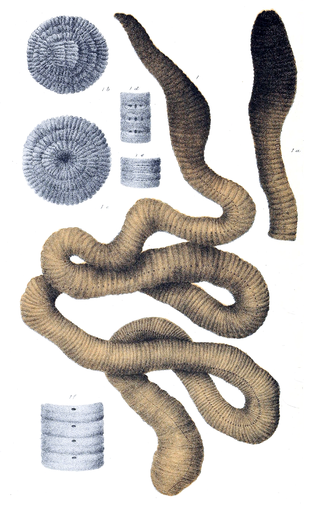
The giant Gippsland earthworm, is one of Australia's 1,000 native earthworm species.

Lumbricus rubellus is a species of earthworm that is related to Lumbricus terrestris. It is usually reddish brown or reddish violet, iridescent dorsally, and pale yellow ventrally. They are usually about 25 millimetres (0.98 in) to 105 millimetres (4.1 in) in length, with around 95–120 segments. Their native distribution was mainland Europe and the British Isles, but they have currently spread worldwide in suitable habitats.
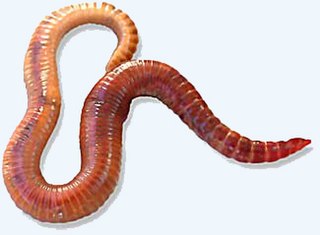
Eisenia fetida, known under various common names such as manure worm, redworm, brandling worm, panfish worm, trout worm, tiger worm, red wiggler worm, etc., is a species of earthworm adapted to decaying organic material. These worms thrive in rotting vegetation, compost, and manure. They are epigean, rarely found in soil. In this trait, they resemble Lumbricus rubellus.
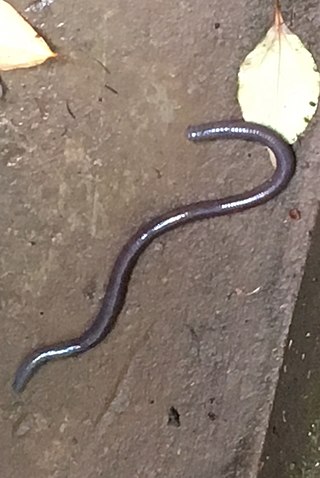
Pheretima is a genus of earthworms found mostly in New Guinea and parts of Southeast Asia.
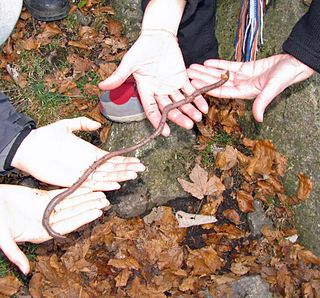
Lumbricus badensis is a type of giant earthworm, a species of annelid. It is endemic to the upper-elevation spruce forests of Germany's Black Forest, where its common name is Badischer Riesenregenwurm. It inhabits exclusively the region between the mountains Feldberg and Belchen, and the Wiese Valley at elevations above 1000 m. Up to 60 cm in length, this earthworm is one of the largest European species. It weighs between 25 and 35 g and lives in subterranean tubes which are up to 2.5 m deep. It feeds on organic matter it ingests from the surface and aerates the soil as it moves through it, contributing to the formation of humus. It is prey for foxes and owls. An informational trail about this giant earthworm, the Riesenregenwurm-Erlebnispfad, has been established on Belchen mountain.

An earthworm is a soil-dwelling terrestrial invertebrate that belongs to the phylum Annelida. The term is the common name for the largest members of the class Oligochaeta. In classical systems, they were in the order of Opisthopora since the male pores opened posterior to the female pores, although the internal male segments are anterior to the female. Theoretical cladistic studies have placed them in the suborder Lumbricina of the order Haplotaxida, but this may change. Other slang names for earthworms include "dew-worm", "rainworm", "nightcrawler", and "angleworm". Larger terrestrial earthworms are also called megadriles as opposed to the microdriles in the semiaquatic families Tubificidae, Lumbricidae and Enchytraeidae. The megadriles are characterized by a distinct clitellum and a vascular system with true capillaries.
Microchaetus rappi, the African giant earthworm, is a large earthworm in the family Microchaetidae, the largest of the segmented worms. It averages about 1.4 meters in length, but can reach a length of as much as 6.7 meters and can weigh over 1.5 kilograms.
Lumbrokinase is a class of fibrinolytic enzymes present in earthworm species including Lumbricus bimastus and Lumbricus rubellus.
Earthworms are invasive species throughout the world. Of a total of about 6,000 species of earthworm, about 120 species are widely distributed around the globe. These are the peregrine or cosmopolitan earthworms. Some of these are invasive species in many regions.

Dendrodrilus rubidus is a species of earthworm in the family Lumbricidae. It is native to Europe, and it is a widespread introduced species, occurring on every continent except Antarctica, as well as many islands. It is often invasive. It is sometimes used as fishing bait, and is marketed under many nonspecific names, including red wiggler, jumping red wiggler, red trout worm, jumbo red worm, and pink worm. Other common names include bank worm, tree worm, and gilt tail.

Aporrectodea is a genus of earthworms in the family Lumbricidae. The genus includes some of the most common earthworms in the Palearctic realm and in agricultural soils across the temperate regions of the world.

Aporrectodea rosea, the rosy-tipped worm, is a species of earthworm commonly found in Europe especially in Ukraine.
Lumbricus festivus, also known as the Quebec worm, is a type of earthworm, a species of annelid.
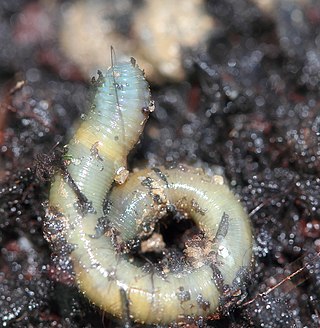
Allolobophora is a genus of annelids belonging to the family Lumbricidae.

Octolasion lacteum is a species of earthworm of the genus Octolasion. In New Zealand it has been found in West Coast soils and in Canterbury. They are found in mostly moist areas deep under the soil as they feed in the nutrients within the soil. Unlike other worm species, these are known to survive in acidic soil as well as soil that is not as organic compared to other places. They provide some important roles in the ecosystem as well as threats to other species as well. After a drought, they help the soil get more organic by adding more carbon dioxide in the soil and the waste from the O. lacteum also provides nutrients for the soil. In another case, they can also be invasive in a way that they suck up carbon in the soil which means plants have less causing a disruption to the food web. Lastly, they reproduce by cross parthogenic reproduction.












